by Lisa Cooke | Oct 29, 2016 | 01 What's New, Brick Wall, Research Skills |
Another brick wall…busted! We all have trouble spots in our family history research. Sometimes, we just need a little help breaking through. Here’s a tried-and-true method for using the genealogy FAN club principle to overcome brick walls in your family history research from guest author Amie Bowser Tennant.

A FAN club stands for Family, Associates, and Neighbors. Using the FAN club principle is a process in which genealogists identify a list of people (family, associates, and neighbors) that lived and associated with a given ancestor. By researching these other people, you may flesh out some new hints for your own research. Ultimately, identifying our ancestors FAN club is an effective tool for overcoming brick walls in genealogy research.
Renowned genealogist and author Elizabeth Shown Mills, coined the phrase “FAN Club” for genealogical purposes. She points out the significance of not only searching records for an ancestor’s surname, but also paying attention to documents about the ancestor’s “FAN Club” (Friends, Associates, Neighbors). Historical information, she says, is like real estate: the true value of any piece of information is unknown until it is put into community context. Learn more in Elizabeth’s “QuickSheet: The Historical Biographer’s Guide to Cluster Research (the FAN Principle).”
Step 1: “F” Stands for Family
Searching out other family members may prove helpful. Like in the case of Michael Knoop of Miami County, Ohio, I noticed there was another man in the county named Jacob Knoop. What was even more unique is both Michael and Jacob were born in New Brunswick. How unusual, I thought! Two men with the same last name, both born in New Brunswick, living in a small, farming area in Ohio! They had to be related, and they were. Jacob was Michael’s older brother.
Because I was having trouble finding when Michael had come to America, I traced Jacob instead. I located the passenger list with Jacob’s name on it and in doing so, I viewed all the passengers and found Michael, their mother, and lots of siblings!

Image above: Creating a FAN club with Family
In the case of Catherine Fearer Coddington, wife of James Coddington, I was having difficulty finding who her parents were. By searching for other Fearer individuals in the area, I discovered a biographical sketch on a John Fearer, Jr. Historical Encyclopedia of Illinois, Volume 2, reads:
“In 1836[,]John Fearer [Jr.] brought his family to Illinois. From Wheeling, West Va., the journey was made entirely by water. A landing on the Illinois soil was made at Hennepin. James Coddington, from near the Fearer’s old home in Maryland had already settled north of Princeton, in Bureau County, and later married John Fearer’s sister Catherine. The family found a home at Coddington’s until Mr. Fearer rented land near by.”
Catherine had a brother! With this new information, I was able to easily trace John’s father to John Fearer, Sr. of Allegany County, Maryland and finally connect Catherine to her parents through a probate record.
It’s easy to see what a powerful strategy researching the relatives of your ancestors can be!
Step 2: “A” Stands for Associates
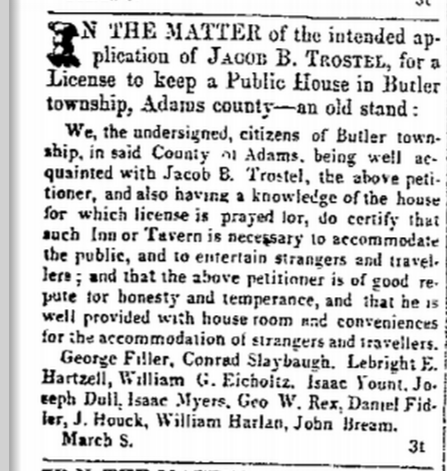
Creating a FAN club with Associates
An associate could be a business partner, a witness on a document, a pastor, a lawyer, or the man that bailed Grandpa out of jail! Associates are often related. To create a list of associates, you might start gathering all witnesses to vital events, such as baptismal or christening records, marriage records, probate, land, and affidavits.
Were the courthouse records in your targeted area destroyed? Check the local newspapers for clues for possible associates. As an example, Jacob Trostel was a signee and vouched for Harvey D. Wattles’ tavern license. The license and names of the vouchers were listed in the newspaper, too. Eleven other men of the community appear on that petition. Later, Jacob himself petitions for a tavern license. That petition is signed by twelve men: George Filler, Conrad Slaybaugh, Lebright E. Hartzell, William G. Eicholtz, Isaac Yount, Joseph Dull, Isaac Myers, George W. Rex, Daniel Filler, William Harlan, and John Bream.
In both of these examples, relatives of Jacob Trostel had been vouchers. By tracing them, we were able to find out more about Jacob and his family.
Step 3: “N” Stands for Neighbors
Where can we find a list of our ancestors neighbors? A census, of course! When looking at a census page, we look for other people on the page with the same surname as our targeted ancestor. There’s a good chance those folks could also be related. But, your ancestor’s neighbors may also hold rich clues that can help you in your research. Many neighbors intermarried, sold land to each other, and even migrated to new locations together.
Besides looking at individuals listed on the same census page as your ancestor, remember to turn the page! Sometimes, a neighbor is not on the same page as your ancestor, but rather the pages before or after. Just because a person appears directly after your ancestor on the census rolls doesn’t necessarily mean they were neighbors. This only indicates the order in which the census taker visited the homes. You might also be able to identify close neighbors by looking at land ownership maps for the area. In this way, you can easily identify who lived near-by.
If you are having difficulty determining where your ancestors came from, researching the neighbors may give the answer. Many neighbors migrated together. Always check at least one page before your ancestor and one page after your ancestor in any given census.
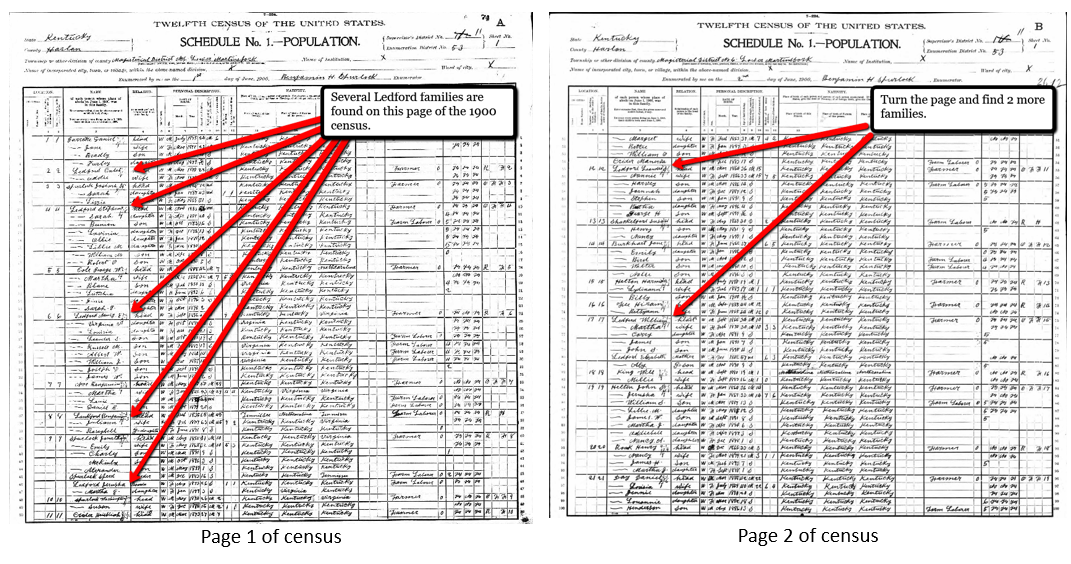
Image above: A FAN Club with Neighbors
Genealogy Fan Club: Comments and More Resources
There are likely dozens of successful ways for creating a FAN club for your ancestor. We would love to hear your examples in the comments below. For even more ways to break through those genealogy brick walls, enjoy these links below.
Read our article Solve Your Genealogy Brick Walls: 3 Tips for Breaking Through!
 Even better: Genealogy Gems Premium Members can watch Lisa’s one hour video class Brick Walls: Cold Case Investigative Techniques. In this video you’ll not only learn how to apply criminal cold case strategies to your brick walls, but you’ll also get loads of fresh and innovative ideas you can try right away. If you are not a Premium Member yet, learn more about becoming a Genealogy Gems Premium Member here.
Even better: Genealogy Gems Premium Members can watch Lisa’s one hour video class Brick Walls: Cold Case Investigative Techniques. In this video you’ll not only learn how to apply criminal cold case strategies to your brick walls, but you’ll also get loads of fresh and innovative ideas you can try right away. If you are not a Premium Member yet, learn more about becoming a Genealogy Gems Premium Member here.
by Lisa Cooke | Jul 15, 2023 | 01 What's New, Artificial Intelligence, Genealogy Gems Podcast, Technology |
AUDIO PODCAST SHOW NOTES: Get the very latest on the major update Google has made to Bard, and the answer to the question “Should I use Bard, ChatGPT, or any of the other chatbots for genealogy research?” I’ve got some surprising answers for you!
Listen to the Podcast Episode
To Listen click the media player below (AUDIO ONLY):
Watch the Original Video
You can watch the video version: SHOCKING RESULTS! Should you use AI Chatbots for Genealogy?
Genealogy Gems Premium Members Exclusive Download:
Download the handy PDF show notes that complement this podcast episode.
Also covered in this episode: Google just announced an update to Bard. New features include:
- Pin and rename conversations
- Export code to more places
- Share responses with friends
- Images in prompts
Become a Genealogy Gems Premium Member
Premium Members have exclusive access to:
- Video classes and downloadable handouts
- The Genealogy Gems Premium Podcast
- Elevenses with Lisa downloadable ad-free show notes PDF cheat sheets
Become a member here. Learn more about Genealogy Gems Premium Membership.

Click to learn more about Genealogy Gems Premium Membership.
Genealogy Gems Podcast App
Don’t miss the Bonus audio for this episode. In the app, tap the gift box icon just under the media player. Get the app here.
Get the Free Genealogy Gems Newsletter
The Genealogy Gems email newsletter is the best way to stay informed about what’s available with your Premium eLearning Membership. Sign up today here.
Our Sponsors:
MyHeritage:
Click here to start finding your family history at MyHeritage
Learn more: watch MyHeritage 10 “Don’t Miss” Features You Need.
Visit Fort Wayne
Fort Wayne, Indiana is the home of the second-largest free genealogy library in the country. Make plans today to visit one of my favorite genealogy libraries!
Learn more at https://www.visitfortwayne.com
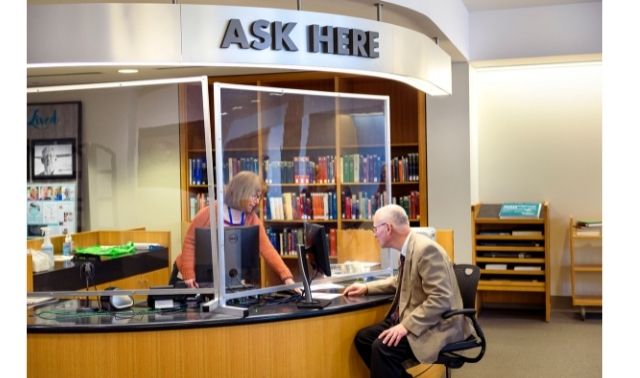
Follow Lisa and Genealogy Gems on Social Media:
Resources
Download the handy PDF show notes that complement this podcast episode.
by Lisa Cooke | Jul 21, 2018 | 01 What's New, Trees |
Is the tail wagging the dog in your genealogy research? Resist the temptation to jump at each hint and online family tree. Instead, take the lead in your own research and follow the scent of each clue with genealogical best practices. Here’s how…
Almost as soon as you start adding information to your family tree on any of the major genealogy records sites (Ancestry, MyHeritage, Findmypast) you will start getting suggestions. These suggestions are known by a variety of names on the various sites, such as hints, Shaky Leaves, Smart Matches, record matches, etc. No matter what they’re called, they can be a great way to quickly make even more progress in growing your family tree.
There’s an old saying: you get what you pay for. In the case of hints, you have technically paid for them by subscribing to the genealogy website’s service. However, you didn’t pay for them through careful research following solid genealogical methodology. You haven’t yet verified their accuracy, or in the case of suggested online family tree, verified their sources.

Online family trees are one of the most common types of hints you’ll receive. And it’s no wonder: there are billions of names entered in online family trees*, so your tree is very likely to match some of them.
However, with all those matching trees there are bound to be problems. If you’ve been wondering about the reliability and usability of other people’s online family trees being recommended as hints, you’re not alone. Keep reading to learn more about using information gleaned from other’s online family trees.
The question of trusting online family trees
Brenda is a Premium eLearning member, and she wrote me recently with a question about using online family trees:
“I’m just getting back into my genealogy research after 10 years of not having time. It seems that research has completely changed to online work! I’m getting [hints that link to other] family lines, but can I trust them?”
And this related question comes from Douglas:
“Weekly, I get emails with family tree matches, asking me to confirm the match. My problem is not with the matching but with when I dig into their tree, the source for their information is another tree. That info may be a clue but I learned way back that the info needed to be backed up by good primary and sometimes secondary sources, not what somebody thought was right. Info that I entered in my tree years ago and found subsequently to be wrong is still hanging out in a dozen trees. What is your opinion?”
My guess is that at some point you’ve had some of the same questions as Brenda and Douglas. Am I right? Well, even though it’s exciting to find someone who’s already built a family tree that includes your ancestors, it’s important to proceed with caution. Avoid the temptation to “graft” or copy the tree onto your tree.
That’s not to say you should ignore online trees. Instead, let’s discuss how reliable they are and how to use them wisely and responsibly.
How to use online family trees as hints
Douglas has stated the problem accurately. The researchers behind those tantalizing trees may have made mistakes or copied unfounded information without verifying it. Unfortunately, this is a very common occurrence.
Once copied to one tree, incorrect information can easily get picked up by others and copied over and over again. And the problem is made worse because the more it’s copied, the more unskilled researchers may assume it must be accurate because they see everyone using it. It’s a vicious circle indeed!
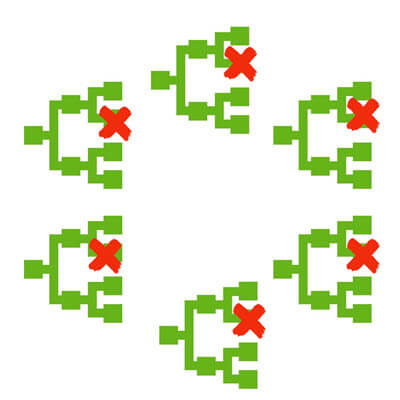
Mistakes can happen in online family trees
Approach every online hint and tree as a clue – a lead – to be considered and scrutinized. You won’t know the accuracy of it for sure until you review the research and verify the sources. That being said, the next logical questions would be “how in the world will I have enough time to verify all of the information in all of these trees?”
The answer is, you don’t.
Instead, do your own genealogical research first, one person and one generation at a time. Work from the present generation backward and learn everything you can from known and trusted primary and secondary sources. If this idea sounds new to you, I strongly encourage you to start listening to my Family History: Genealogy Made Easy podcast. It’s free, and available here on my website, as well as through all major podcast apps. If you’re new to genealogy or returning after a long spell, this podcast will cover the basics in genealogical research and help you get on track.
 It’s easy to let other people’s online trees give you a false sense that you are quickly and easily building your own family tree, but it’s just not true. A tree worth having is a tree worth researching. Don’t let the tail wag the dog here. Follow the proven genealogical research process, and then tap into online family trees when you need a fresh new lead.
It’s easy to let other people’s online trees give you a false sense that you are quickly and easily building your own family tree, but it’s just not true. A tree worth having is a tree worth researching. Don’t let the tail wag the dog here. Follow the proven genealogical research process, and then tap into online family trees when you need a fresh new lead.
Automated record hints and matches
On genealogy websites, you’ll get two types of automated hints or matches. The first is for other people’s trees, which we’ve already discussed. The second is for historical genealogical records.
In order to deliver the historical record hint, the website has compared the data on your tree with the data available in the transcriptions of their records. Since many people share the same name and other distinguishing characteristics like birth dates, it’s important to look at each record closely and carefully.
Review both the record transcription and the digitized image of the document (when available), keeping in mind that not all the useful genealogical data is always transcribed. And in the process of transcribing, errors may have been made.
You first want to evaluate whether this document pertains to your relative. Next, you will need to determine what else it adds to your knowledge of them. Compare what that document says to what you’ve already learned about your family. Watch for multiple, specific pieces of evidence that support or are consistent with what you already know.

Genealogy Giants guru Sunny Morton says that “record hints on Genealogy Giants FamilySearch and MyHeritage are especially known for a high degree of accuracy; Ancestry.com’s are generally pretty good, too, but the site is clear about reminding you that these are just hints. I don’t have data on how accurate Findmypast hinting is, but I do know that they’ve been adding more records to the pool of records they hint on, and that’s also good.”
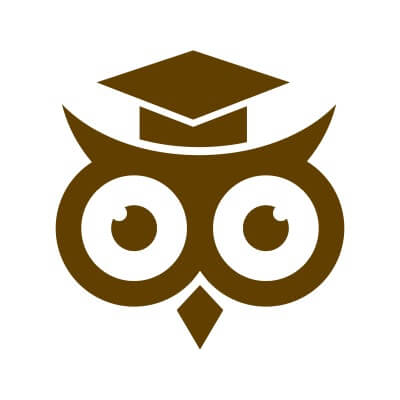 After reviewing all the record hints you’ve received, conduct additional searches yourself for records about each ancestor. Use the same process described above to scrutinize and evaluate each record.
After reviewing all the record hints you’ve received, conduct additional searches yourself for records about each ancestor. Use the same process described above to scrutinize and evaluate each record.
Remember that even a digitized record hosted on one of the major websites can have transcription, spelling, or other errors, and sometimes you’ll have to make judgment calls. There’s no substitute for your brain! And there’s no substitute for carefully verifying and documenting every discovery as you go.
Next steps for using hints and trees wisely
By using hints for online family trees and historical records as leads when needed rather than the main path to follow will help you build an accurate family tree.
We are here to help you take control of your family tree and your research every step of the way. For specific information about reviewing record hints, read Getting started on Ancestry.com.
When you do find errors in someone else’s tree, here’s some sound advice for How to approach someone about errors on their family tree.
And finally take a moment to read Don’t lose control when you post your family tree online.
If you’re a Genealogy Gems Premium eLearning member like Brenda, I suggest Genealogy Gems Premium Podcast episode 152. It features my audio interview with Sunny Morton on take-home strategies for using hinting tools at the Genealogy Giants.
Disclosure: This article contains affiliate links and Genealogy Gems will be compensated if you make a purchase after clicking on these links (at no additional cost to you). Thank you for supporting Genealogy Gems!




 Even better: Genealogy Gems Premium Members can watch Lisa’s one hour video class Brick Walls: Cold Case Investigative Techniques. In this video you’ll not only learn how to apply criminal cold case strategies to your brick walls, but you’ll also get loads of fresh and innovative ideas you can try right away. If you are not a Premium Member yet, learn more about becoming a Genealogy Gems Premium Member here.
Even better: Genealogy Gems Premium Members can watch Lisa’s one hour video class Brick Walls: Cold Case Investigative Techniques. In this video you’ll not only learn how to apply criminal cold case strategies to your brick walls, but you’ll also get loads of fresh and innovative ideas you can try right away. If you are not a Premium Member yet, learn more about becoming a Genealogy Gems Premium Member here.





 It’s easy to let other people’s online trees give you a false sense that you are quickly and easily building your own family tree, but it’s just not true. A tree worth having is a tree worth researching. Don’t let the tail wag the dog here. Follow the proven genealogical research process, and then tap into online family trees when you need a fresh new lead.
It’s easy to let other people’s online trees give you a false sense that you are quickly and easily building your own family tree, but it’s just not true. A tree worth having is a tree worth researching. Don’t let the tail wag the dog here. Follow the proven genealogical research process, and then tap into online family trees when you need a fresh new lead.
 After reviewing all the record hints you’ve received, conduct additional searches yourself for records about each ancestor. Use the same process described above to scrutinize and evaluate each record.
After reviewing all the record hints you’ve received, conduct additional searches yourself for records about each ancestor. Use the same process described above to scrutinize and evaluate each record.